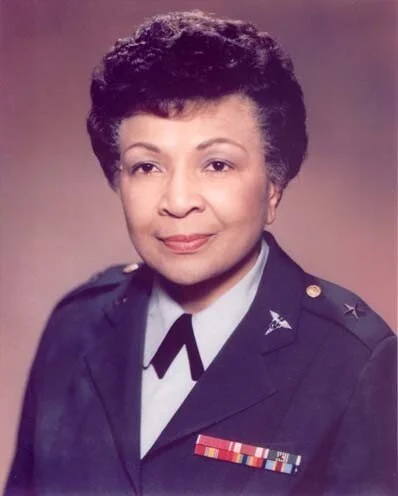Hazel Johnson-Brown
Sadly the United States is still a deeply segregated country, if not legally then socially and economically. When Hazel Johnson-Brown was born on October 10, 1927, segregation was the law of the nation. Even though her country did not treat her as an equal citizen because of her sex and her race, she served all of us for decades.
Johnson-Brown was one of seven children born to Garnett Henley Johnson and Clarence L. Johnson Sr. in West Chester, Pennsylvania. The family of four sons and three daughters lived on a farm in nearby Malvern, a Quaker community. Farming was a challenging life, but the family valued education, too. By the time Johnson-Brown was 12 years old, she decided she wanted to be a nurse instead of continuing with the domestic labor she was doing to help support the family.
Medical careers were difficult for women in the 1940s unless they wanted to be nurses, but even then, if their skin color wasn’t pale enough, they could be rejected by many schools, as well as hospitals and private clinics. Pennsylvania was not a strictly segregated state, so the Johnson family had a white nurse who understood Johnson-Brown’s desire to follow that same profession. With a bit of help from an experienced nurse, admission to the Harlem Hospital School of Nursing in New York City was possible in 1947. Johnson-Brown graduated from that school with her nursing diploma in 1950.
She spent the next three years working at Harlem Hospital’s emergency ward before returning to Pennsylvania. She was quickly promoted to head nurse at the medical cardiovascular ward at the Philadelphia Veteran’s Hospital in 1953 after just three months there. She went back to school during this time to work on a bachelor’s degree in nursing. Her colleagues suggested she look into joining military service to further her education and career. While the military was also racist, it had recently been desegregated by President Harry S. Truman, and thus there may have been more opportunities for advancement based on merit, not solely on skin color.
So in 1955, seven years after the desegregation of the military, Johnson-Brown joined the Army as a nurse until 1958. After a year back in the civilian world, she returned and joined the Army Nurse Corps’ Registered Nurse Student Program so she could continue her education. A fuller list of all her military assignments can be found at the Army Women’s Foundation’s website.
In 1959, she earned a bachelor’s degree in nursing from Villanova University, a private Catholic university in Pennsylvania. VU gave her their College of Nursing Medallion in 1984 in recognition of her achievements. She also earned a master’s degree from Columbia’s Teacher’s College back in New York City in 1963 and a doctorate in educational administration from Catholic University of America in Washington, D.C., in 1978. In 1986, in recognition of her accomplishments, the Alumni Association of CUA gave her their Alumni Achievement Award.
Johnson-Brown initially served in the Army in Japan. She was a surgical nurse and soon impressed her superiors enough that she was able to rise through the ranks further than any black woman before her, starting in the 1960s, where she trained nurses on their way to Vietnam. She was Project Director at the US Army Medical Research and Development Command in the Army Medical Department field hospital system from 1967-1973. For the next five years, she served in several prominent positions as Dean of the Walter Reed Army Institute of Nursing; at the Office of the Surgeon General; as a member of the 8th Army Command; and as Chief Nurse at the US Army Hospital/121 Evacuation Hospital in Seoul, Korea.
In 1978, she became the first black woman to reach the rank of Brigadier General and was given command of the 7,000-member-strong Army Nurse Corps. The ANC itself allowed only white women until 1947 and let in men a few years later during the Korean War. In the Army, she hoped she was judged for more than just the color of her skin, she said in an interview with the Washington Post in 1979 after her promotion. Beyond those two firsts, Johnson-Brown also become the first officer of her rank in the Department of Defense with an earned doctorate.
Among her promotions, Johnson-Brown was named Army Nurse of the Year twice. She was also awarded the Distinguished Service Medal, the Legion of Merit, the Meritorious Service Medal, and Army Commendation Medal. Using her authority, she created academic scholarships for Reserve Officer Training Corps (ROTC) nursing students and established a clinical nursing summer camp for ROTC cadets. She helped create and then publish the first Standards of Practice for the Army Nurse Corps. Johnson-Brown didn’t only want to lead, she wanted to encourage others to help the Corps grow and develop. She pushed for more civilian training for military nurses at the graduate level and encouraged nurses to do research and publish. She helped establish symposia and conferences for Army nurses where they could meet to learn and support each other.
Johnson-Brown married David Brown in 1981, but the couple had no children. They later divorced, but Johnson-Brown kept her hyphenated name.
After retirement from military duty in 1983, Johnson-Brown continued to serve the nation. She joined the faculty at George Mason University and become the director of their Center for Health Policy, a program she helped create. After she was named a professor emeritus at GMU’s College of Nursing and Health Science in 1996, she remained active with their advisory board until her death. She also served for several years as part of the American Nurses Association’s government relations unit.
Johnson-Brown died from Alzheimer’s disease at the age of 83 on August 5, 2011. You can find more information about her and view her Army uniform in a display at the National Museum of African American History and Culture, which opened in 2016. George Mason University created the General Hazel Johnson-Brown Scholarship in 2018 in honor of their former Center for Health Policy director.


